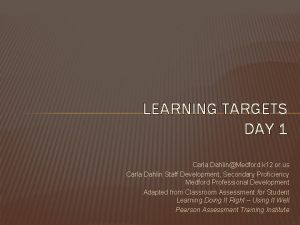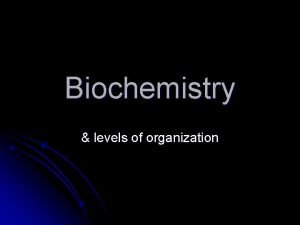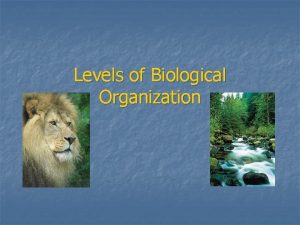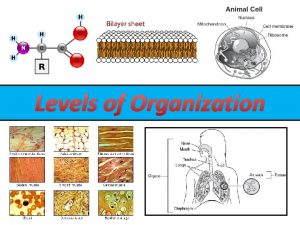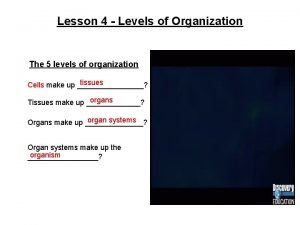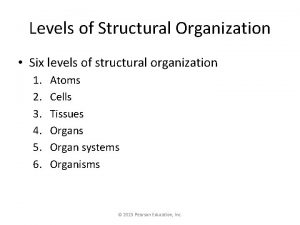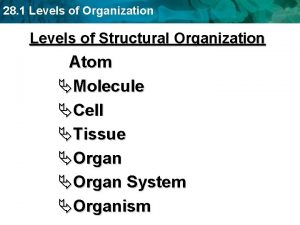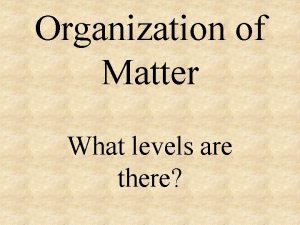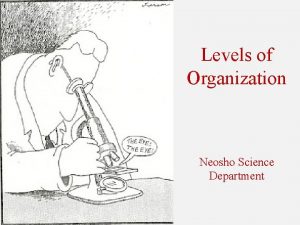Cells and Levels of Organization Learning Targets Use






























- Slides: 30

Cells and Levels of Organization

Learning Targets • Use a model to show mitosis makes simple and complex organisms so that I can understand growth and repair of the body.

Success Criteria • I can explain how cells have different jobs to help an organism live. • I can explain how differentiation created multicellular organisms. • I can explain how genes make different cells with different jobs.

Cells A. Cells are found in all organisms B. Cells are considered the basic units of life

Cell Theory 1. All organisms are made of one or more cells. 2. Cells are the basic units of structure and function 3. New cells come from other living cells by the process of cell division (meiosis and mitosis).

Review of Mitosis • Definition: how a cell divides while keeping the original chromosome number. Divides 1 cell into 2 identical daughter cells • Mitosis has 4 major phases: 1. Prophase 2. Metaphase 3. Anaphase 4. Telophase

Purpose of Mitosis • All of the body’s non-reproductive cells divide by mitosis, like skin cells, muscle cells and blood cells. • Mitosis helps organisms grow, heal wounds and replace countless cells that are shed every minute. • Mitosis is also a type of asexual reproduction for some single cell organisms

Go to Activity 2 in your packet and sketch the steps of Mitosis in the spaces provided. Make observations next to your drawings of what is occurring. Telophase Prophase Anaphase Metaphase

Cancer • One example of mitosis not working the right way is cancer. • Cancer is the result of the genes controlling mitosis not working properly • This leads to unnecessary replication and out-of-control cell and tissue growth.

Basic Cell Types • Prokaryotic Cells • Eukaryotic Cells

Prokaryotic Cells • Do not have a nucleus or nuclear membrane enclosing their DNA. • Do not have membrane-bound organelles like mitochondria or the golgi apparatus • Prokaryotic cells make up the smallest single-celled organisms — bacteria.

Eukaryotic Cells • Usually have at least one membraneenclosed structure, the nucleus. • Have organelles (like tiny organs) • Are present in all living organisms (animals, plants, fungi, protists) except bacteria.


Activity 3 • Watch the “Amoeba Sisters” Youtube video using the link below. • https: //www. youtube. com/watch? v=Pxujitlv 8 wc • As you watch, complete the handout for Activity 3 of the packet that goes with the video.

Animal Cell Structure Organelles: a specialized structure with a specific function • Plasma Membrane • Golgi Apparatus • Cytoplasm • Lysosomes • Nucleus • Mitochondria • Endoplasmic Reticulum • Vacuole • Ribosomes • Cilia and Flagella


Site where parts of the cell are put together. • Rough ER has ribosomes on its surface to make proteins • Smooth ER helps make lipids

• Mitochondria: The “mighty mitochondria” supply the “power” to the cells • • Function: to break down chemical compounds into energy for the cell Lysosomes: Lysosomes contain enzymes to help break down lipids, carbohydrates and proteins into small molecules that can be used by the rest of the cell.

• Vacuole: Vacuoles are structures that are used to store water in plant cells; they are small in animal cells. • Chloroplasts: Plant cells have chloroplasts that capture the energy from sunlight and convert it into chemical energy. • Cell Wall: Plant cells and many prokaryotes (bacteria) also have another outer layer called the cell wall to support and protect the cell

Cell Membrane ● A thin flexible barrier known as the CELL MEMBRANE surrounds all cells ● STRUCTURE: a double layer called a lipid bilayer ● Controls what enters and leaves the cell ● Protects and supports the cell

Organelles Important for Protein Synthesis • Nucleus: where the DNA is located ——-> site of transcription which makes m. RNA from the DNA • Ribosomes (including those on the Endoplasmic Reticulum, aka Rough ER): site of translation——> making a protein from the m. RNA • Golgi Apparatus: proteins get packaged into vesicles and sent to different areas of the cell

Practice: Can you label the diagram using the terms provided? • • Protein Rough ER DNA Vesicle RNA Nucleus Golgi Ribosome


Organization of Cells A. A cell that exists on its own is a single-celled or unicellular organism. 1. Unicellular organisms carry on all characteristic properties of life 2. Examples — bacteria, protozoa, many algae and some fungi

Organization of Cells A. Multicellular organisms — may be made up of hundreds, thousands, millions or billions of cells. • In multicellular organisms, the cells are specialized, cannot live independently and each type of cell carries out only some of the life processes. • These relationships require many levels of organization and interaction.

Multicellular Organisms Cells differentiate from stem cells so that they can do a lot of different jobs in the body. • They all still have the same DNA, but genes are ‘turned on’ or ‘turned off’ • ex/ We don’t want cells in our eyes making stomach acid •

Tissues • made up of a group of cells working together (Ex: epithelial tissue, connective tissue, muscle tissue).

Organs • a group of tissues that work together to perform a specific function • Ex: the stomach has nerve, muscle and blood tissues together to perform a function

Organ Systems • a group of organs that work together to perform a specific function • Ex: digestive system- includes the mouth, esophagus, stomach, intestines, pancreas, liver…

Organisms • a group of organ systems that work together to do all things needed for life
 Writing learning targets
Writing learning targets Agonist antagonist muscles
Agonist antagonist muscles Cameron todd willingham house address
Cameron todd willingham house address Knowledge targets examples
Knowledge targets examples Learning targets knowledge, reasoning, skill product
Learning targets knowledge, reasoning, skill product Learning target
Learning target Paranasal sinus at birth
Paranasal sinus at birth Red blood cells and white blood cells difference
Red blood cells and white blood cells difference Venn diagram for animal and plant cells
Venn diagram for animal and plant cells Masses of cells form and steal nutrients from healthy cells
Masses of cells form and steal nutrients from healthy cells Tubular secretion
Tubular secretion Thyroid gland
Thyroid gland How are somatic cells different from gametes
How are somatic cells different from gametes Somatic vs germ cells
Somatic vs germ cells Eukaryotic vs prokaryotic cells
Eukaryotic vs prokaryotic cells Prokaryotic cells vs eukaryotic cells
Prokaryotic cells vs eukaryotic cells The organelle trail
The organelle trail Pseudostratified vs simple columnar
Pseudostratified vs simple columnar What animals have prokaryotic cells
What animals have prokaryotic cells Prokaryotic cell wall
Prokaryotic cell wall Nondisjunction in meiosis
Nondisjunction in meiosis Cell substance
Cell substance Objectives of warehouse
Objectives of warehouse Identifying market segments and targets chapter 9
Identifying market segments and targets chapter 9 Identifying market segments and targets chapter 9
Identifying market segments and targets chapter 9 Identifying market segments and targets chapter 9
Identifying market segments and targets chapter 9 Five patterns of target market selection
Five patterns of target market selection Segment by segment invasion
Segment by segment invasion Surfaces of thyroid gland
Surfaces of thyroid gland Smarter balanced claims and targets
Smarter balanced claims and targets Identifying market segments and targets
Identifying market segments and targets



